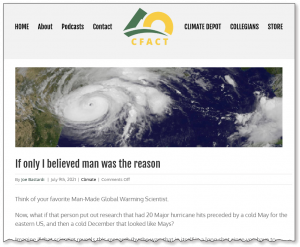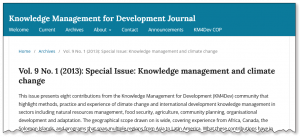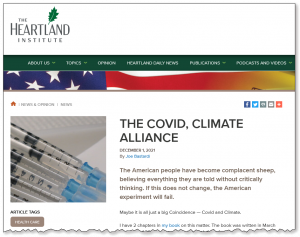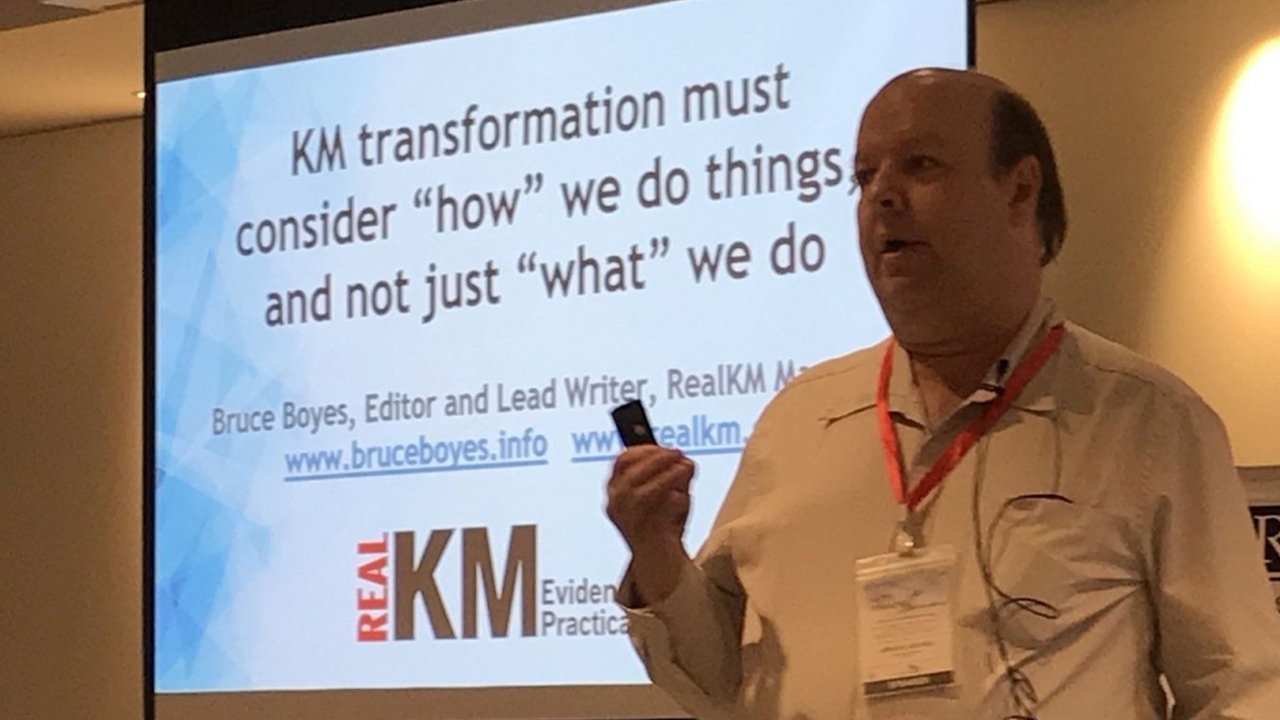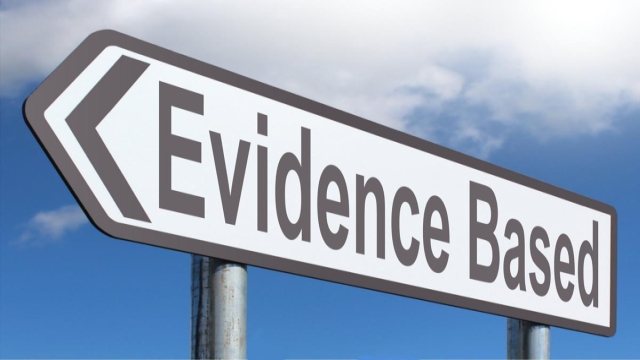
Critical Eye: Why those climate views can’t be given equal voice and hearing
Critical Eye is a semi-regular feature where RealKM analyses and discusses the methodology and science behind claims made in publications.
I recently posted a link on my LinkedIn profile to the Ideas for Sustainability article “How is Indigenous and local knowledge being lost due to climate change? Exploring tangible and intangible cultural heritage in the face of change.”
The Ideas for Sustainability article reports on recently published peer-reviewed academic research1 that synthesised key themes and gaps in the understanding of climate-driven losses to indigenous and local knowledge (ILK) and cultural heritage from around the world. This study was carried out by researchers from The University of Queensland, and published in The Anthropocene Review, an academic journal.
In response to my LinkedIn post, I received the following comments from a knowledge management (KM) colleague:
Please stop conflating the political climate change hysteria with the business of KM …
Bruce Boyes I hope you will give this and similarly focused views equal voice and hearing.
www.climatedepot.com/2021/07/12/meteorologist-joe-bastardi-if-only-i-believed-man-was-the-reason
The link in my colleague’s second comment is to the July 2021 article “If only I believed man was the reason” by Joe Bastardi2, a meteorologist and weather forecaster with WeatherBELL Analytics. Bastardi is considered a climate science denier / skeptic because he rejects the 99% scientific consensus on climate change.
Should the business of KM be disassociated with climate change, and can Bastardi’s article and similarly focused views be given equal voice and hearing to The University of Queensland research that was the reference for my LinkedIn post?
I will first look at the relationship between KM and climate change, and then critically appraise Bastardi’s article.
Knowledge management and climate change
Contrary to the first comment that my colleague made on my LinkedIn post, knowledge management (KM) has a recognised role in supporting action to address climate change.
The 2030 Agenda for Sustainable Development was adopted by all United Nations member states in 2015. At its heart are the 17 Sustainable Development Goals (SDGs), one of which, Goal 13, focuses specifically on climate change:
Goal 13: Take urgent action to combat climate change and its impacts
Recognising the role of KM in supporting the achievement of the SDGs, including Goal 13, the preamble to the Agenda Knowledge for Development, which has been prepared by the Knowledge for Development Partnership (K4DP), states that:
In September 2015, the member states of the United Nations (UN) General Assembly ratified the Sustainable Development Goals (SDGs), a transformational agenda to address the problems facing the global community, including poverty, gender inequality, and climate change …
We recognise that the SDGs set the framework of the international development agenda up to the year 2030 …
This Agenda for Knowledge Development is designed to complement the SDGs by providing an integrated approach to knowledge-related challenges that directly influence the achievement of the SDGs.
The indigenous and local knowledge (ILK) focus of the University of Queensland research that was the basis of my LinkedIn post is directly relevant to the 14 goals of the Agenda Knowledge for Development. For example:
Goal 3: Local knowledge ecosystems …
3.3 There needs to be a more widespread recognition that knowledge development efforts have to build on local realities and existing local knowledge …
3.5 Indigenous peoples and their distinct knowledge systems must be acknowledged and supported.
Further reinforcing that KM has a recognised role in supporting action to address climate change, the Knowledge Management for Development (KM4D) Journal has published a special issue3 on this topic.
The KM4D Journal is published in cooperation with the Knowledge Management for Development (KM4Dev) international community, with which RealKM Magazine has a close partnership.
Bastardi’s article “If only I believed man was the reason”
I will now critically appraise Joe Bastardi’s article “If only I believed man was the reason.” Bastardi himself encourages such an approach, writing recently that people need to apply critical thinking rather than believing everything they are told.
1. A false claim and the loaded question fallacy
Bastardi begins his article with the following sentences:
Think of your favorite Man-Made Global Warming Scientist.
Now, what if that person put out research that had 20 Major hurricane hits preceded by a cold May for the eastern US< and then a cold December that looked like the Mays.
Imagine if that scientist reveals this research. (btw that in itself is a long shot since you have to forecast all the time and be looking for ideas that are not obvious… which is what forecasting actually does if you do it long enough).
In these opening sentences, Bastardi poses a “what if?” question based on the premise that he, through his work as a weather forecaster, has gained a unique and previously unknown insight in regard to the cause of an increased frequency of major hurricane landfalls in the United States in particular years. Hurricanes are a form of extreme weather event.
Bastardi’s claimed unique and previously unknown insight is that natural climate variations are the likely contributor to the increased frequency of major hurricane extreme weather events in particular years. As indicated by the title of his article, “If only I believed man was the reason,” this claim aligns with Bastardi’s view that extreme weather events occur naturally, and that there is not enough evidence to support the conclusion that human-induced climate change is a factor.
As evidence for his claimed insight, Bastardi provides in the body of his article a series of climate anomaly observation charts and hurricane track maps, with associated commentary centred on climate oscillations. He focuses primarily on the Madden-Julian Oscillation (MJO), with the concluding sentences of his article stating that:
I believe this is too strong a correlation to ignore …
Why can this possibly have any merit? Because the large-scale feedback of the atmosphere over a long time scales sets in motion action and reaction that may indeed be more obvious due to the distorted warming and increased water vapor. But it would take a lot of research …
And guess what, I suspect the MJO amplitude in the spring is involved.
However, Bastardi’s narrative in this regard is seriously misleading. The reason that climate oscillations such as the MJO have been defined and described at all is because climate variability is a recognised and extensively researched phenomena. Indeed, a whole year of my work was spent doing nothing else but synthesising, analysing, and carrying out research in regard to the effect of climate variability on river flows, and in turn, the effect of this flow variability on river ecology.
Based on this knowledge, I wrote two blog posts highlighting how climate variability was a significant factor in two devastating extreme weather flood events in eastern Australia in 2011 and 2013 (please read those brief blog posts before continuing with this article). Additionally, a year ago, I also used this knowledge to accurately predict the high probability of a further significant flood event in eastern Australia, as outlined in my presentation to an International Society for Knowledge Organization (ISKO) Singapore Chapter forum in April (please view that brief presentation before continuing with this article).
My prediction was based on a strong La Niña and a notable negative trend in the Pacific Decadal Oscillation (PDO) after the PDO had been mostly positive or only slightly negative since early 2014. Right now, I’ll go even further to predict the high likelihood of devastating flood events in eastern Australia again this summer due to yet another strong La Niña and the PDO trending significantly negative (-3.15 in October 2021), as it did at the time of the 2011 and 2013 floods.
Given that climate variability is extensively researched, it is unsurprising to find that the United States has a Climate Variability and Predictability (CLIVAR) research program:
US Climate Variability and Predictability (CLIVAR) is a national research program with a mission to foster understanding and prediction of climate variability and change on intraseasonal-to-centennial timescales
It is also unsurprising to find that, among their investigation of a number of MJO weather and climate interactions, CLIVAR has been looking at whether MJO predictions could help forecast periods of enhanced hurricane activity. This is the very thing about which Bastardi has claimed to have gained a unique and previously unknown insight. However, the current version of a CLIVAR research summary4 first published at least five years before Bastardi’s article states that:
Tropical cyclogenesis preferentially occurs during certain phases of the MJO … For example, an analysis during 1949-1997 indicates that the MJO strongly modulates Gulf of Mexico and Caribbean Sea hurricanes and tropical storms … The modulation of major hurricanes (Categories 3-5) by the MJO is even more pronounced.
Because the existence of a relationship between the MJO and hurricane extreme weather events is both accepted science and a focus for ongoing research, Bastardi’s claim of having gained a unique and previously unknown insight in this regard is false. This makes the associated “what if?” question that he asks in the opening sentences of his article an example of the “loaded question” fallacy.
According to the The Internet Encyclopedia of Philosophy (IEP), which is a scholarly, peer-reviewed resource, the loaded question fallacy5 can be defined as:
Loaded Question
Asking a question in a way that unfairly presumes the answer.
2. The suppressed evidence fallacy
Another notable aspect of Bastardi’s article is that while it includes climate anomaly observation charts, it completely lacks any references from the body of peer-reviewed academic literature. This is despite the fact that directly relevant references exist, as listed in the CLIVAR research summary referenced above.
This stands in complete contrast to The University of Queensland research that was the reference for my original LinkedIn post. Not only was that study peer-reviewed research published in a reputable academic journal, but it was also a systematic review of 100 other peer-reviewed studies. As we advise in the RealKM Magazine guidance and resources for evidence-based knowledge management, systematic reviews6 produce a reliable knowledge base through accumulating findings from a range of studies.
It also stands in complete contrast to the extensive reference lists in the substantial government reports7,8,9 that I wrote as the outcomes of my work on the river flows project mentioned above, and the critical scientific advisory panel and independent review of these publications prior to their publication (for example, the knowledge review report went through nearly 100 review drafts).
It also stands in stark contrast to the more than 14,000 research papers read by the 234 scientists who wrote most recent report10 from the Intergovernmental Panel on Climate Change (IPCC), and the critical review of this report prior to its publication. As the IPCC advises:
The IPCC is committed to preparing reports that aim for the highest standards of scientific excellence, balance, and clarity. Multiple stages of review are an essential part of the IPCC process to ensure a comprehensive, objective and transparent assessment of the current state of knowledge of the science related to climate change. Expert Reviewers and governments are invited at different stages to comment on the scientific, technical and socio-economic assessment and the overall balance of the drafts. The review process includes wide participation, with hundreds of reviewers critiquing the accuracy and completeness of the scientific assessment contained in the drafts.
But not only do IPCC reports undergo rigorous review, they also go through a rigorous endorsement process by the 195 member countries of the IPCC. As the IPCC advises:
As the culmination of a report’s development, IPCC member governments endorse the report. The endorsement process is based on a dialogue between those who will use the report – the governments – and those who write it – the scientists. Endorsement by governments acknowledges that the report is a definitive assessment that has been developed following the IPCC’s defined procedures, underpinning the report’s authority.
Bastardi’s failure to include in his article known and readily accessible scientific evidence that is directly relevant to his claimed insights in regard to the MJO and hurricane extreme weather events is an example of the “suppressed evidence” fallacy.
According to The Internet Encyclopedia of Philosophy (IEP), the suppressed evidence fallacy11 can be defined as:
Suppressed Evidence
Intentionally failing to use information suspected of being relevant and significant is committing the fallacy of suppressed evidence. This fallacy usually occurs when the information counts against one’s own conclusion.
3. The straw man fallacy
Through his article title “If only I believed man was the reason” and (false) claim of having gained a unique and previously unknown insight in regard to MJO and hurricanes, Bastardi is inferring that climate scientists are wrong to conclude that human-induced climate change has impacted on hurricane extreme weather events.
However, not only has Bastardi suppressed evidence directly relevant to his MJO and hurricane extreme weather events claim, as discussed in section 2 above, but he has also suppressed evidence directly relevant to human-induced climate change and hurricanes.
This suppressed evidence is reviewed in the comprehensive research summary12 titled “Global Warming and Hurricanes” prepared and regularly updated by the Geophysical Fluid Dynamics Laboratory (GFDL) of the United States government’s National Oceanic and Atmospheric Administration (NOAA). The current version of this research summary reflects the findings of the most recent IPCC report, which was referenced above.
Contrary to Bastardi’s inference that climate scientists are wrong to conclude that human-induced climate change has impacted on hurricane extreme weather events, the NOAA/GFDL research summary shows that climate scientists haven’t actually yet drawn this conclusion (as at 9 August 2021). NOAA/GFDL states that:
we conclude that it is premature to conclude with high confidence that increasing atmospheric greenhouse gas concentrations from human activities have had a detectable impact on Atlantic basin hurricane activity, although increasing greenhouse gases are strongly linked to global warming … However, there is increasing evidence that the increase in tropical storm frequency in the Atlantic basin since the 1970s has been at least partly driven by decreases in aerosols from human activity and volcanic forcing. However, this does not imply that the increase will continue into the future, as a number of models project that greenhouse gas warming will lead to future decreases in Atlantic tropical storm frequency. Anthropogenic forcing may have already caused other changes in Atlantic hurricane activity that are not yet confidently detectable due to the small magnitude of the changes or observation limitations, or due to limitations in modeling and physical understanding (e.g., aerosol effects on regional climate, uncertainties in simulation of Atlantic multidecadal variability).
This means that Bastardi’s inference that climate scientists are wrong to conclude that human-induced climate change has impacted on hurricane extreme weather events is an example of the “straw man” fallacy.
According to The Internet Encyclopedia of Philosophy (IEP), the straw man fallacy13 can be defined as:
Straw Man
Your reasoning contains the Straw Man Fallacy whenever you attribute an easily refuted position to your opponent, one that the opponent wouldn’t endorse, and then proceed to attack the easily refuted position (the straw man) believing you have thereby undermined the opponent’s actual position. If the misrepresentation is on purpose, then the Straw Man Fallacy is caused by lying.
4. The black-or-white fallacy
In this final section, we move from looking specifically at the “If only I believed man was the reason” article to examine the fundamental view on which Bastardi based this article. This is the view that extreme weather events occur naturally, and that there is not enough evidence to support the conclusion that human-induced climate change is a factor. This view suggests that there are only two options – either extreme weather events are caused by natural variability, or they are caused by climate change.
However, there is a third option. This is that both natural variability and climate change exist simultaneously, and interact. I’ve already discussed this in a previous RealKM Magazine article, where I provide research evidence supporting both climatic variability and climate change as compounding factors in the horror bushfire crisis that was experienced in southeastern Australia in the summer of 2019-2020 (please read that article before continuing with this article).
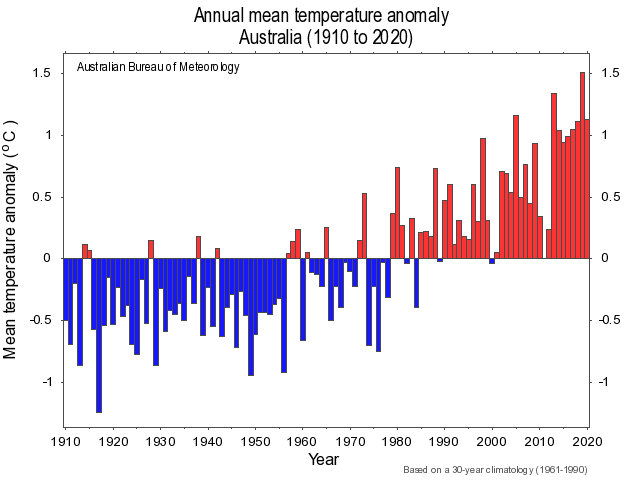
As shown in the time series graph above, annual national mean temperatures in Australia have been progressively increasing over the time period of 1910 to 2020. This progressive temperature increase is human-induced climate change. In the summer of 2019-2020, these increased temperatures came together with extremely dry conditions as a result of the coincidence of particular points on the cycles of a number of climate oscillations, collectively creating unprecedented conditions for bushfire ignition and spread.
This means that Bastardi’s suggestion that there are only two options in regard to extreme weather events – that is, either they are caused by natural variability, or they are caused by climate change – is an example of the “black-or-white” fallacy.
According to The Internet Encyclopedia of Philosophy (IEP), the black-or-white fallacy14 can be defined as:
Black-or-White
The Black-or-White fallacy or Black-White fallacy is a False Dilemma Fallacy that limits you unfairly to only two choices, as if you were made to choose between black and white.
Conclusion
In regard to the first comment that my colleague made on my LinkedIn post, the Agenda Knowledge for Development identifies that knowledge management (KM) has an important role in supporting the achievement of Goal 13 of the Sustainable Development Goals (SDGs), which is to “Take urgent action to combat climate change and its impacts.” Further reinforcing that KM has a recognised role in supporting action to address climate change, the Knowledge Management for Development (KM4D) Journal has published a special issue on this topic.
In regard to my colleague’s second comment, Joe Bastardi’s article “If only I believed man was the reason” is unscientific in the extreme, with fallacious reasoning and a complete lack of peer-reviewed supporting evidence despite the existence of relevant references. In summary:
- A false claim and the loaded question fallacy. Because the existence of a relationship between the Madden-Julian Oscillation (MJO) and hurricane extreme weather events is both accepted science and a focus for ongoing research, Bastardi’s claim of having gained a unique and previously unknown insight in this regard is false. This makes the associated “what if?” question that he asks in the opening sentences of his article an example of the “loaded question” fallacy.
- The suppressed evidence fallacy. Bastardi has failed to include in his article known and readily accessible scientific evidence that is directly relevant to his claimed insights in regard to the MJO and hurricane extreme weather events. This failure is an example of the “suppressed evidence” fallacy.
- The straw man fallacy. Bastardi has also suppressed scientific evidence directly relevant to human-induced climate change and hurricanes. This evidence shows that, contrary to Bastardi’s inference that climate scientists are wrong to conclude that human-induced climate change has impacted on hurricane extreme weather events, climate scientists haven’t actually yet drawn this conclusion. This means that Bastardi’s inference in this regard is an example of the “straw man” fallacy.
- The black-or-white fallacy. Bastardi’s suggestion that there are only two options in regard to extreme weather events – that is, either they are caused by natural variability, or they are caused by climate change – is incorrect because scientific evidence supports a third option. This is that both natural variability and climate change exist simultaneously, and interact. This means that Bastardi’s apparent consideration of only two options is an example of the “black-or-white” fallacy.
This means that there is absolutely no way that Bastardi’s article can be given equal voice and hearing to the peer-reviewed systematic review that was the reference for my original LinkedIn post. Indeed, the only rational and scientifically valid hearing that such a deeply flawed article can be given is the critique that it has received above. The same would apply to similarly focused views.
Lessons for knowledge management
The lessons for the knowledge management (KM) community from the above analysis and critique include:
Importance of evidence-based KM and critical appraisal
Consistent with its founding objective, RealKM Magazine promotes and supports evidence-based KM because it leads to better outcomes.
The Center for Evidence-Based Management (CEBMa) advises15 that there are six steps in evidence-based practice:
Evidence-based practice is about making decisions through the conscientious, explicit and judicious use of the best available evidence from multiple sources by
- Asking: translating a practical issue or problem into an answerable question
- Acquiring: systematically searching for and retrieving the evidence
- Appraising: critically judging the trustworthiness and relevance of the evidence
- Aggregating: weighing and pulling together the evidence
- Applying: incorporating the evidence into the decision-making process
- Assessing: evaluating the outcome of the decision taken
to increase the likelihood of a favorable outcome.
Bastardi’s article “If only I believed man was the reason” does not demonstrate the “conscientious, explicit and judicious use of the best available evidence from multiple sources.” This means that it falls well short of the standard of evidence acquisition (step 2) that anyone engaged in evidence-based practice should be expected to achieve.
Further, if seeking to use Bastardi’s article itself as an evidence source, a knowledge manager practicing evidence-based KM should be expected to first critically appraise the trustworthiness and relevance of the article (step 3) (or alternatively, to engage someone with relevant professional expertise in the conduct of this task – see below). As summarised in the conclusion above, Bastardi’s article fails this critical appraisal step.
The use of dark side KM tactics16 reinforces the need for the critical appraisal of claims that challenge scientific consensus. As previously discussed in RealKM Magazine, environmental science has long been the target of such tactics, for example information suppression17 and outright fakery.
To help build KM sector capability in regard to evidence-based practice, RealKM Magazine has published a comprehensive collection of guidance and resources, including information literacy resources to assist with critical appraisal.
Valuing and engaging with professional expertise
In addition to the six steps in evidence-based practice, the Center for Evidence-Based Management (CEBMa) identifies four sources of evidence:
- Scientific literature – empirical studies.
- Organisation – internal data.
- Stakeholders – values and concerns.
- Practitioners – professional expertise.
In regard to the “practitioners – professional expertise” aspect, as well as having professional expertise directly related to the focus of Bastardi’s article, as discussed above, I have more than two decades of experience in evidence-based environmental management, including in regard to climate change, and a Master of Environmental Management with Distinction that included extensive study of climate science.
In the context of discussions related to climate change and climate science, a knowledge manager practicing evidence-based KM should be expected to both value and engage with such professional expertise.
References:
- Pearson, J., Jackson, G., & McNamara, K. E. (2021). Climate-driven losses to Indigenous and local knowledge and cultural heritage. The Anthropocene Review, 20530196211005482. ↩
- Wikipedia, CC BY-SA 3.0. ↩
- Cranston, P., & Jackson, C. (2013). Editorial. Knowledge management and climate change. Knowledge Management for Development Journal, 9(1), 1-5. ↩
- Maloney, E. (n.d.). The MJO and Hurricanes, Could MJO Predictions Help Forecast Periods of Enhanced Hurricane Activity? US Climate Variability and Predictability (CLIVAR). ↩
- IEP. (n.d.). Fallacies, Loaded Question. The Internet Encyclopedia of Philosophy (IEP), ISSN 2161-0002. ↩
- Briner, R. B., & Denyer, D. (2012). Systematic review and evidence synthesis as a practice and scholarship tool. Handbook of evidence-based management: Companies, classrooms and research, 112-129. ↩
- Boyes, B. (2006). Determining and managing environmental flows for the Shoalhaven River, Report 1 – Environmental Flows Knowledge Review. NSW Department of Natural Resources. ISBN: 0 7347 5719 0. ↩
- Boyes, B. (2006). Determining and managing environmental flows for the Shoalhaven River, Report 2 – Environmental Flows Investigations. NSW Department of Natural Resources. ISBN: 0 7347 5778 6. ↩
- Boyes, B. (2006). Environmental water requirements for the Shoalhaven River estuary. Discussion Paper, Shoalhaven River Environmental Flows Scientific Advisory Panel, March 2006. ↩
- IPCC. (2021). Summary for Policymakers. In Masson-Delmotte, V., Zhai, P., Pirani, A., Connors, S. L., Péan, C., Berger, S., Caud, N., Chen, Y., Goldfarb, L., Gomis, M. I., Huang, M., Leitzell, K., Lonnoy, E., Matthews, J.B.R., Maycock,T. K., Waterfield, T., Yelekçi, O., Yu, R., & Zhou, B. (eds.) Climate Change 2021: The Physical Science Basis. Contribution of Working Group I to the Sixth Assessment Report of the Intergovernmental Panel on Climate Change. Cambridge University Press. ↩
- IEP. (n.d.). Fallacies, Suppressed Evidence. The Internet Encyclopedia of Philosophy (IEP), ISSN 2161-0002. ↩
- Knutson, T. (2021, August 9). Global Warming and Hurricanes, An Overview of Current Research Results. NOAA/GFDL. ↩
- IEP. (n.d.). Fallacies, Straw Man. The Internet Encyclopedia of Philosophy (IEP), ISSN 2161-0002. ↩
- IEP. (n.d.). Fallacies, Black-or-White. The Internet Encyclopedia of Philosophy (IEP), ISSN 2161-0002. ↩
- Barends, E., Rousseau, D. M., & Briner, R. B. (2014). Evidence-based management: The basic principles. Amsterdam: Center for Evidence-Based Management. ↩
- Alter, S. (2006, January). Goals and tactics on the dark side of knowledge management. In Proceedings of the 39th Annual Hawaii International Conference on System Sciences (HICSS’06) (Vol. 7, pp. 144a-144a). IEEE. ↩
- Driscoll, D. A., Garrard, G. E., Kusmanoff, A. M., Dovers, S., Maron, M., Preece, N., … & Ritchie, E. G. (2021). Consequences of information suppression in ecological and conservation sciences. Conservation Letters, 14(1), e12757. ↩
Also published on Medium.

